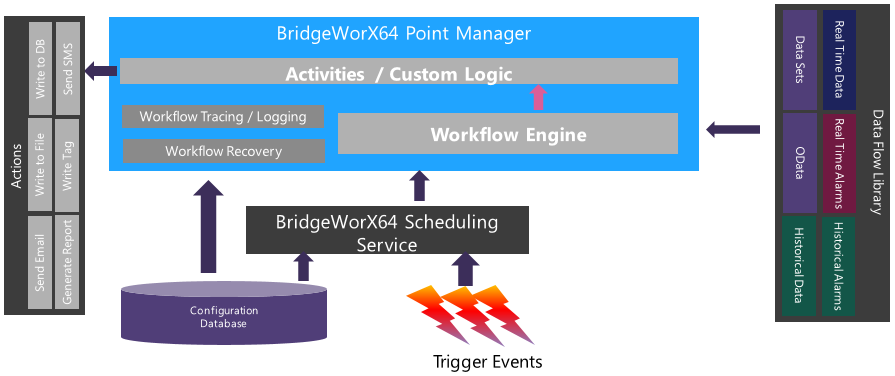About Bridging

The Bridging provider in the Workbench, based on ICONICS' BridgeWorX technology, provides graphical data bridging, taking advantage of multi-core, 64-bit systems as well as utilizing .NET 4.6 and the Parallel Tasks Library.
It also fully integrates with ICONICS V10 Platform Services, including:
-
Common Workflow Execution Engine
-
Data Flow Library
-
GridWorX
-
Web Services
-
BI Server
-
OData (REST)
-
Facility AnalytiX, Energy AnalytiX, AlertWorX, ReportWorX, etc.
Bridging Architecture

The Bridging provider in the Workbench provides multiple user benefits, including:
See BridgeWorX V10.96 New Features for more info on the latest version updates.
Transaction Workflow Execution
Transaction Workflow Execution includes:
-
Diagram Designer - providing custom control flow logic
-
Drag & Drop configuration of Transaction Diagram Activities
-
Connectivity to heterogenous data sources
-
On Complete, On Success, On Fail, On True, On False control flow branching
-
Ability to execute custom .NET code in a Transaction
Transaction Triggering
Transaction Triggering provide the following trigger types:
-
Manual
-
Periodic
-
On OPC Data Value Change
-
On Alarm
-
On Database Value Change
-
On File/Directory Change
-
On NT Event posted
Enterprise Service Design
Enterprise Service Design provides:
-
Multithread/multicore design with Parallel Task Library
-
Concurrent Transaction execution on a Thread Pool
-
Workflow Priorities: Normal, Below Normal, Above Normal
-
If the Workflow Engine is already running at maximum capacity, then other submitted workflows are enqueued in the Priority Queue.
-
Powerful transaction options for enqueuing transactions:
-
Queue and Execute immediately
-
Queue and Execute if no other similar transaction is running
-
Queue and Execute if no other similar transaction is running or enqueued
Transaction Recovery Option
The Transaction Recovery Option provides:
-
Heartbeat of running Transaction
-
Recovery Options
-
No Recovery
-
Re-Execute from Start
Transaction Data Sources
All transaction data sources will come from the BridgeWorX DataFlow engine. Real 'live' data sources (i.e., those driven by subscription-based callbacks) are converted into datasets at the moment of consumption.
Single values (e.g., OPC DA, BACnet, SNMP, etc.) are represented as a simple data set containing at least a value, quality and timestamp. However, they may include any additional properties requested by the user (e.g., engineering units, high/low range, etc.).
Current alarms (e.g. OPC A&E, BACnet, custom point managers, etc.) are transformed into a dataset (table) when activity executes (like a snapshot of a "current" active alarms pattern).
Data sources that are not subscription-based, but require polling, will make use of reader blocks to control exactly when the Read is executed, including:
-
Datasets (e.g., Web Services, Database Queries, custom point managers)
-
Historical Data (e.g., OPC HDA, BACnet, custom point managers, etc.) are transformed into a dataset (table)
-
CSV files
-
XML files
-
JSON files
Transaction Activities
Transaction Blocks (activities) are used to manipulate the data. Internally, they handle data as in-memory datasets.
All Reader Activities will have at least one output dataset.
The Expression Syntax allows users to use any Activities output value of row X, column Y in expression calculations.
Variables
Global and Local Variables in Bridging in the Workbench are typed DataSets. Schema defines column names and column data types. Global Variables are exposed by BridgeWorX64 Point Manager as DataSets.
Elements of Global, Local, Trigger Variables or Parameters could be used as data sources or in expression calculations.
Configuration
Bridging configuration is easy to use and maximizes available space within the Workbench tool. It is possible to use Drag & Drop within transactions. Each activity has an intuitive configuration tool, with no popups. A handy library of activities is available, as well as visual feedback about any errors within diagrams.
See Also: